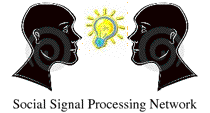Rationale
Like anthropologists say it, "space speaks". Whenever left free to move in a large environment (e.g., the hall of a hotel, a square, a street, a garden, a waiting room, a restaurant, etc.), people seem to wander without precise criteria, but actually respect patterns and trajectories largely dominated by social mechanisms. An invisible bubble seems to surround each person and keeps people far from one another unless there are physical constraints or the space is too crowded.
Social bonds, whether they involve only two persons or a large group of individuals, are shown by decreasing mutual distances between people and by delimiting regions of space close to others. Social messages like dominance, inclusion, exclusion and rapport are communicated via mutual positioning, body orientation and posture.
Computer vision & pattern recognition are the main technologies used for automatic monitoring of public spaces. Effective approaches for tracking people, recognizing poses, postures, gestures, collective crowd phenomena in public environments have been developed in the last years, especially in the video surveillance context, aimed at classifying (suspect, unusual, abnormal) behaviors. However, they all seem to forget that, for humans, physical and social space are tightly intertwined and no intelligent monitoring is possible without taking into account social aspects associated to behaviors displayed under the eyes of the cameras.
This workshop aims at filling this gap by gathering, for the first time together, researchers active in computer vision and pattern recognition, human sciences and automatic behavior understanding. Joint research across these communities will have a major impact on any technology that can benefit from automatic monitoring approaches, including video-surveillance, architecture, ambient intelligence, marketing, office space design, urbanism, etc..
Topics
The workshop is focused on high-quality original research that join computer vision and pattern recognition, human sciences and automatic behavior understanding areas. Topics of interest include (but are by no means limited to):
- Proxemics
- Human ethology
- Kinesics
- Spatial Empathy
- Territoriality
- Expressions and emotions
- Tracking: multi-person, multi-camera, group/crowd
- Motion segmentation and analysis
- Crowd/group analysis and simulation
- Social force models
- Collective and emergent behaviour
- Gesture/Action recognition
- Activity analysis
- Multi-person/group/crowd interaction analysis
- Spatial and temporal reasoning
- Sensory integration and data fusion
- Situation awareness and understanding
- Applications: Ambient Intelligence, Surveillance and Monitoring, Domotics, Intelligent, Perceptual Marketing
Keynote speakers
- Karl Grammer (Ludwig Boltzmann Institute for Urban Ethology, Austria)
- Pascal Fua (Ecole Polytechnique Federale Lausanne, Switzerland)
Program
| 08.45 | Opening | |
| 09.00 | Invited Talk: “Show me how you move and I tell you who you are: body motion and personality” | Karl Grammer (Ludwig Boltzmann Institute for Urban Ethology, Austria) |
| 10.00 | Coffee break | |
| 10:30 | People Trajectory Mining with Statistical Pattern Recognition | Simone Calderara and Rita Cucchiara |
| 11:00 | Dense Spatio-Temporal Motion Segmentation for Tracking Multiple Self-Occluding People | Martin Hofmann, Gerhard Rigoll and Thomas Huang |
| 11:30 | Wrong Turn – No Dead End: a Stochastic Pedestrian Motion Model | Stefano Pellegrini, Andreas Ess, Marko Tanaskovic and Luc Van Gool |
| 12:00 | A Socio-Technical Approach for Event Detection in Security Critical Infrastructure | Philipp Blauensteiner, Martin Kampel, Stefan Vogtenhuber and Christoph Musik |
| 12.30 | Lunch break | |
| 14.00 | Invited talk: "Multi-People Tracking through Global Optimization" | Pascal Fua (Ecole Polytechnique Federale Lausanne, Switzerland) |
| 15.00 | Feature Co-occurrence Representation Based on Boosting for Object Detection | Yuji Yamauchi, Masanari Takaki, Takayoshi Yamashita and Hironobu Fujiyoshi |
| 15.30 | Coffee break | |
| 16.00 | Device-Tagged Feature-based Localization and Mapping of Wide Areas with a PTZ Camera | Alberto Del Bimbo, Giuseppe Lisanti, Iacopo Masi and Federico Pernici |
| 16.30 | Real-time Classification of Pedestrians and Cyclists for Intelligent Counting of Non-Motorized Traffic | Ahmed Nabil Belbachir, Stephan Schraml and Norbert Brändle |
| 17.00 | Socially Intelligent Surveillance and Monitoring: Analysing Dimensions of Physical Space | M. Cristani, V. Murino, A. Vinciarelli |
| 17.30 | Discussion | |
| 18.00 | Closing | |
Program committee
F. Bremond (INRIA)
A. Camurri (University of Genova).
R. Chellappa (University of Maryland)
I. Cohen (Honeywell)
R. Cowie (Queen’s University Belfast)
R. Cucchiara (University of Modena Reggio-Emilia)
F. d'Errico (University of Roma Tre),
J. Ferryman (University of Reading)
S. Gong (Queen Mary, University of London)
K. Grammer (Ludwig-Boltzmann-Institute for Urban Ethology)
E. Hendriks (Delft University of Technology)
H. Högni Vilhjálmsson (Reykjavík University)
Y. Ivanov (MERL)
M. Mehu (University of Geneva),
L-P. Morency (Institute for Creative Technologies)
A. Nijholt (University of Twente)
J-M. Odobez (IDIAP Research Institute)
N. Sebe (University of Trento)
M. Shah (University of Central Florida)
M. Turk (University of California, Santa Barbara)
T. Xiang (Queen Mary, University of London)
Organisation
- Vittorio Murino, University of Verona/ Italian Institute of Technology
- Marco Cristani, University of Verona/ Italian Institute of Technology
- Alessandro Vinciarelli, University of Glasgow/ IDIAP Research Institute
- Isabella Poggi, University Roma Tre
Contacts
Email for all inquiries: marco.cristani AT univr.it
on Socially Intelligent Surveillance
and Monitoring (SISM 2010)
